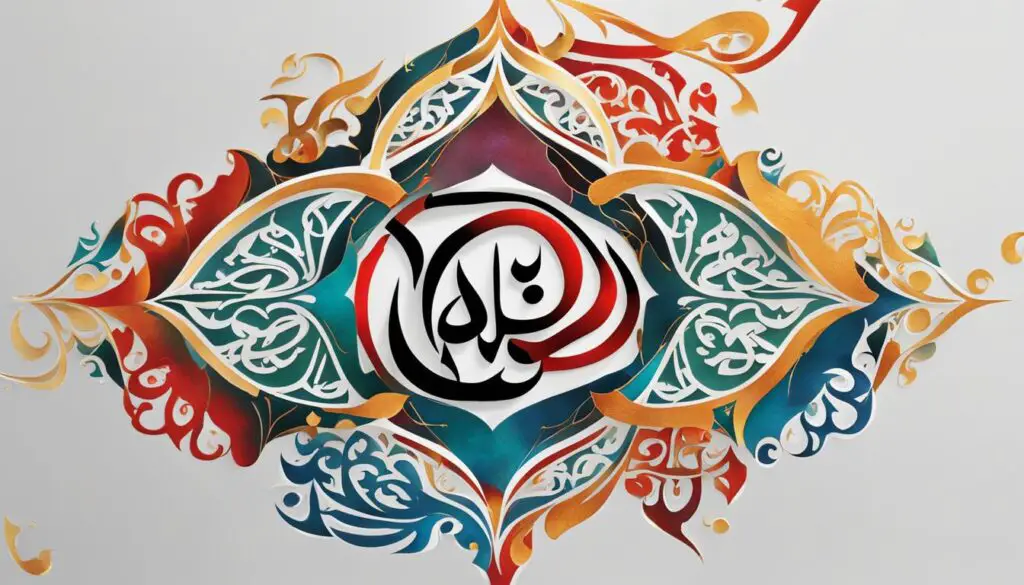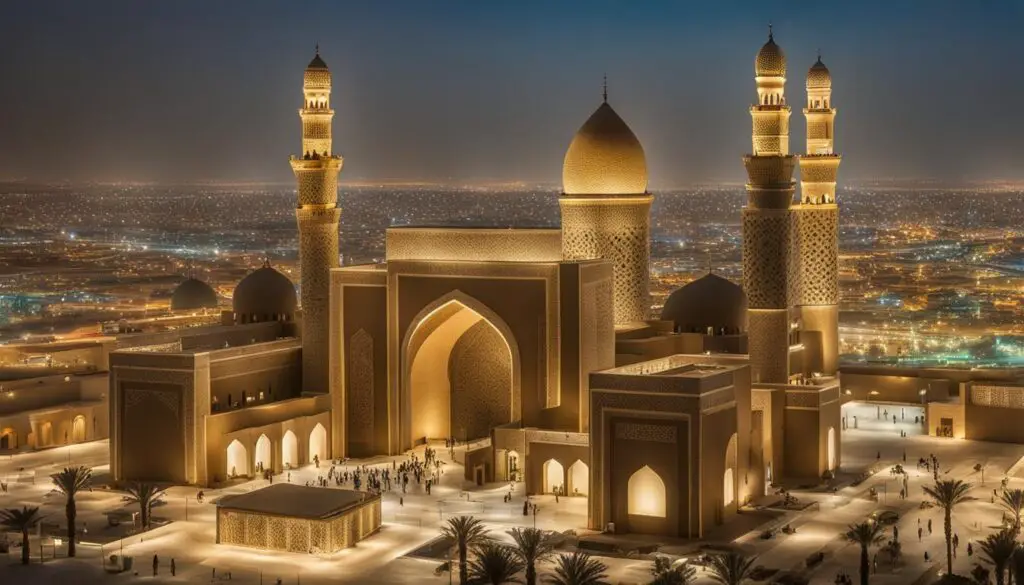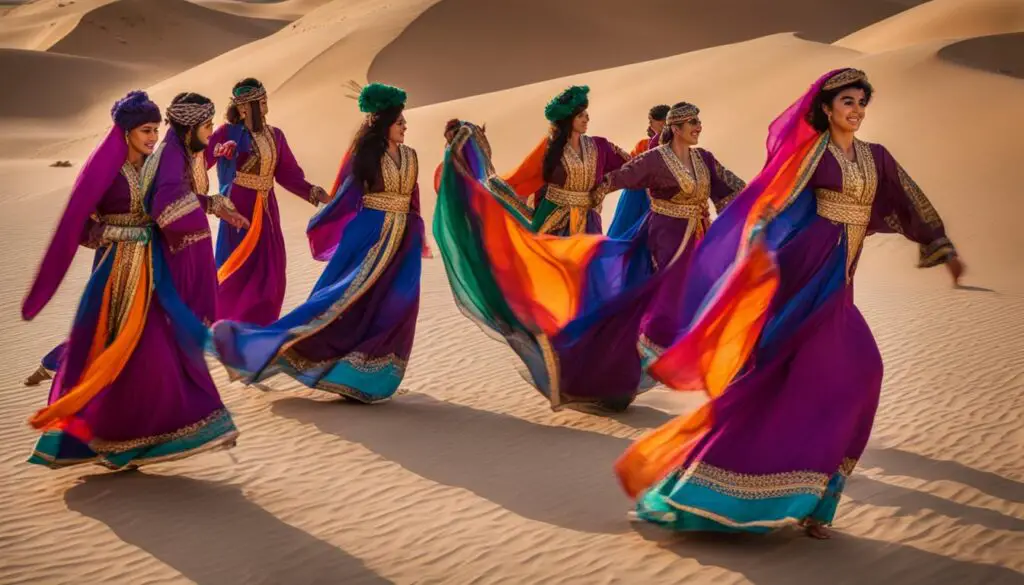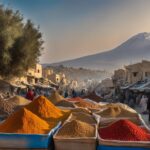Arabia, a region located in the Middle East on the Arabian Peninsula, is steeped in a captivating cultural heritage and historical significance. From the biblical importance of Arabia to its Arab traditions and Arab history, this region has a story to tell that spans centuries.
In biblical times, Arabia played a significant role as a backdrop for notable events and figures. It was a place where biblical figures like Abraham and Moses journeyed through, leaving their mark on its history. The Arabian Peninsula’s vast desert landscapes and trade routes also shaped the region’s cultural exchange and prosperity.
Today, Arabia preserves its rich heritage through traditions, architectural marvels, and cultural institutions that showcase its diverse languages, cuisines, and customs. Let’s embark on a journey to explore the fascinating culture and history of Arabia, from its biblical roots to its vibrant present.
Key Takeaways:
- Arabia holds biblical significance, with figures like Abraham and Moses associated with the region.
- Trade routes passing through Arabia facilitated cultural exchange and economic prosperity.
- Arabian traditions, languages, and cuisines reflect the region’s diverse cultural heritage.
- The Arabian desert and its historical trade routes shaped the region’s history and development.
- Today, Arabia offers a blend of ancient traditions and modern structures, highlighting its rich cultural tapestry.
The Biblical Significance of Arabia
Arabia holds immense biblical importance, with several notable figures and events linked to the region. In biblical times, Arabia was a significant area mentioned in various religious texts. Abraham, a prominent biblical figure, is believed to have traveled through Arabia on his journey from Ur to Canaan. Moses also resided in Arabia for many years and married an Arabian woman named Zipporah. The Exodus, a major biblical event, is believed to have partly taken place in Arabia as the Israelites crossed the Red Sea and wandered in the wilderness.
The prophet Muhammad, the founder of Islam, was born in Makkah, a city in Arabia that holds great religious significance for Muslims worldwide. This birthplace of Islam attracts millions of pilgrims each year, further emphasizing the biblical and religious importance of Arabia.
“Arabia was a significant area mentioned in various religious texts.”
Table: Notable Biblical Figures Associated with Arabia
| Biblical Figure | Role or Event |
|---|---|
| Abraham | Traveled through Arabia on his journey from Ur to Canaan |
| Moses | Resided in Arabia for many years and married an Arabian woman named Zipporah |
| Prophet Muhammad | Born in Makkah, Arabia, and founded Islam |
Understanding the biblical significance of Arabia provides insight into the historical context and cultural heritage of the region. It highlights the deep roots of religious and cultural traditions that continue to shape Arabia’s identity today.
Ancient Trade Routes and Cultural Exchange in Arabia
Arabia’s geographical location at the crossroads of ancient trade routes made it a hub for cultural exchange. As early as 3,000 BC, Arabian merchants played a crucial role in connecting different civilizations, facilitating trade between India, the Far East, Byzantium, and the Mediterranean lands. The introduction of Islam in the 7th century further enhanced cultural exchange, as the religion quickly spread across the Arabian Peninsula and beyond. The Islamic “Golden Age” led to a period of great learning and cultural advancements in areas such as science, philosophy, and the arts. The annual Hajj pilgrimage in Makkah continues to bring Muslims from around the world, further enriching the region’s cultural diversity through the exchange of goods and traditions.
During ancient times, Arabia served as a vital link between the East and the West, with trade caravans traversing its vast deserts and connecting major trading centers. The Arabian Peninsula’s strategic location made it an important stop along the Silk Road, the Incense Route, and other key trade routes. This facilitated not only the exchange of goods but also the exchange of ideas, languages, and cultural practices. The vibrant cultural exchange in Arabia led to the dissemination of knowledge in various fields, including science, mathematics, astronomy, and medicine.
Arabia became a melting pot of different cultures, with merchants, scholars, and pilgrims from various regions converging in its bustling cities. This cultural fusion gave birth to a unique blend of traditions, arts, and customs that continue to shape Arabian culture today. The Arabian Peninsula’s rich history as a hub for trade and cultural exchange has left a lasting impact on the region, and its influence can be seen in various aspects of Arabian culture, including language, cuisine, architecture, and art.
The Ancient Trade Routes of Arabia
Table: Overview of Ancient Trade Routes in Arabia
| Trade Route | Key Destinations | Main Goods Traded |
|---|---|---|
| The Silk Road | China to the Mediterranean | Silk, spices, precious stones, ceramics |
| The Incense Route | Arabian Peninsula to the Mediterranean | Frankincense, myrrh, spices, precious metals |
| The Spice Route | India to the Mediterranean | Spices, textiles, precious stones, ivory |
| The Maritime Trade Route | Arabian Peninsula to East Africa and India | Spices, gold, ivory, exotic woods |
“Arabia’s position as a crossroads of ancient trade routes allowed for the exchange of goods, ideas, and cultural practices. Merchants from different regions brought their unique products and customs, contributing to the rich tapestry of Arabian culture.”
“The development of trade routes in Arabia led to significant economic prosperity, fostering the growth of cities and providing opportunities for cultural and intellectual exchange. The exchange of goods and ideas fueled the progress of various scientific, artistic, and philosophical fields, leaving a lasting impact on Arabian society.”
Arab Traditions and Islamic Heritage
Saudi Arabia is a country deeply rooted in Arab traditions and Islamic heritage. The cultural fabric of Saudi society is shaped by Islamic teachings and Arab customs, which play an integral role in everyday life. Generosity and hospitality are highly valued virtues, with Saudi people known for their warm welcomes and generosity towards guests.
One of the most important religious occasions in Saudi Arabia is the holy month of Ramadan, during which Muslims fast from dawn to dusk. The breaking of the fast, known as iftar, is a time for families and communities to come together and share meals. This month-long observance fosters a sense of unity and spiritual reflection among Saudi Muslims.
The Hajj pilgrimage to Makkah is another cornerstone of Saudi traditions and Islamic heritage. It is one of the five pillars of Islam and holds immense significance for Muslims around the world. Each year, millions of Muslims travel to Makkah to perform the Hajj rites, following in the footsteps of the Prophet Muhammad. The pilgrimage culminates in the celebration of Eid Al-Adha, a festival of sacrifice and commemoration.
Arabian Cuisine: A Delightful Blend of Flavors
Saudi Arabian cuisine is a reflection of the country’s rich cultural heritage. The traditional Arabic diet consists of a wide variety of dishes that offer a delightful blend of flavors and aromas. Staples of Saudi cuisine include rice, lamb, chicken, dates, and aromatic spices such as saffron, cardamom, and cinnamon.
One iconic dish is Kabsa, a flavorful rice dish typically served with spiced meat or chicken. This dish is often enjoyed during celebratory occasions and family gatherings. Another popular dish is Mandi, which features tender roasted meat served with fragrant rice and a side of spicy sauce.
The strong cultural emphasis on hospitality is also evident in Saudi cuisine. Guests are often greeted with a serving of Arabic coffee, known as qahwa, and traditional dates. These offerings symbolize the warm welcome extended to visitors and are an integral part of Saudi hospitality.
Arabian Clothing: Preserving Cultural Identity
The traditional clothing of Saudi men is represented by the thobe (also known as dishdasha), a loose-fitting, ankle-length robe made from lightweight fabric. The thobe is typically white, reflecting the region’s warm climate and cultural customs.
Women in Saudi Arabia wear the abaya, a loose-fitting black cloak that covers the entire body, apart from the face and hands. The abaya is often embellished with intricate embroidery and can be accessorized with a niqab, which covers the face, leaving only the eyes visible.
These traditional garments not only serve practical purposes, such as protection from the sun and sand, but also reflect the cultural values and identity of Saudi Arabia. The attire is a visible symbol of the country’s Islamic heritage and traditional customs.
Preserving Arabia’s Archaeological Heritage
Saudi Arabia, located in the Arabian Peninsula, is dedicated to preserving its rich archaeological heritage. The country recognizes the importance of its ancient sites and has established institutions, such as the Department of Museums and Antiquities and the Department of Archaeology at King Saud University, to ensure the excavation, cataloging, and preservation of prehistoric and historic sites throughout the region. This commitment to preservation extends to the country’s Islamic archaeological heritage, with restoration efforts focused on mosques like the Holy Mosque in Makkah and the Prophet’s Mosque in Madinah.
One notable restoration project is taking place at Madain Saleh, a UNESCO World Heritage site considered to be one of the largest and best-preserved Nabatean cities outside of Jordan. The site features stunning rock-cut tombs and archaeological remains, highlighting the architectural and cultural achievements of the Nabateans. Saudi Arabia’s dedication to preserving sites like Madain Saleh ensures that future generations can appreciate and learn from these historical treasures.
In addition to restoration efforts, Saudi Arabia is actively engaged in archaeological research and exploration. The country has been involved in excavations along the Darb Zubaydah, the historic pilgrimage road to Makkah, uncovering artifacts and shedding light on the historical significance of the route. These archaeological discoveries contribute to the understanding of Arabia’s past and its role in ancient trade and cultural exchange.

Table: Major Archaeological Sites in Saudi Arabia
| Site | Location | Description |
|---|---|---|
| Madain Saleh | Al-Ula | Ancient Nabatean city with well-preserved rock-cut tombs |
| Dariyah | Riyadh | Historic mud-brick settlement and birthplace of the first Saudi state |
| Fau | Hail | Archaeological site dating back to the Bronze Age |
Saudi Arabia’s commitment to preserving its archaeological heritage ensures that the rich history of the Arabian Peninsula continues to be celebrated and studied. By protecting and exploring these ancient sites, the country not only preserves its own cultural identity but also contributes to our collective understanding of human history.
Architecture in Saudi Arabia
Saudi Arabia has a rich architectural heritage that blends traditional designs with modern structures. The country’s unique architectural style is influenced by its climate, geography, and available resources. Traditional building materials such as adobe, stone, red brick, and coral from the Red Sea are commonly used in different regions. Modern Saudi architects draw inspiration from these traditional designs, incorporating Islamic concepts and creating a harmonious integration of tradition and innovation.
The most prominent architectural feature in Saudi Arabia is the minaret, which serves as a symbol of the country’s deep religious roots. These towering structures can be found in every Saudi urban center, standing as a testament to the strong religious ties of the nation. The architecture of Saudi Arabia also reflects its Islamic heritage, with intricate calligraphy adorning mosques and cultural institutions. Calligraphy is considered an essential Islamic art form and is widely seen in the country’s mosques, public offices, and homes.
The fusion of traditional and modern architecture is evident in landmarks such as the King Saud University and the King Khalid International Airport. These structures showcase the innovative use of materials and design elements while preserving the cultural identity of Saudi Arabia. The country’s commitment to architectural preservation can also be seen in the meticulous restoration of historic buildings and neighborhoods, ensuring that Saudi Arabia’s architectural heritage is protected for future generations.
Noteworthy Saudi Architectural Landmarks
| Landmark | Location |
|---|---|
| The Kingdom Centre Tower | Riyadh |
| Al-Masmak Fortress | Riyadh |
| The Clock Tower | Mecca |
| Jeddah Corniche | Jeddah |
| Al-Ula Old Town | Al-Ula |
These architectural landmarks showcase the diverse range of designs and styles found throughout Saudi Arabia. From the towering modern skyscrapers to the well-preserved historic fortresses, each structure tells a story of the country’s rich architectural heritage. Whether exploring the bustling urban centers or the serene historic sites, visitors to Saudi Arabia are surrounded by the beauty and innovation of its architecture.
The Beauty of Calligraphy in Arabia
Calligraphy, considered the quintessential Islamic art form, holds a significant place in Arabian culture. Dating back 1,400 years, calligraphy is widely seen in mosques, public and private offices, and homes. It is especially prevalent in the interior walls of mosques, where inscriptions of verses from the Holy Qur’an are beautifully displayed. Saudi museums showcase rare manuscripts and commissions for calligraphic works, nurturing a new generation of talented artists. Calligraphy’s influence extends beyond paper and walls; it can be found in metalwork, ceramics, glass textiles, painting, and sculpture. The intricate and intricate art of Arabic calligraphy is a testament to the enduring beauty of Arabian culture.

Arabic calligraphy is known for its elegant curves, intricate details, and expressive forms. It encompasses various styles, each with its unique characteristics. The Kufic style, known for its geometric shapes, is one of the oldest calligraphic styles and is often used for architectural inscriptions. The Thuluth style, with its flowing curves and elongated verticals, is commonly used in decorative writing. The Diwani script, with its cursive and ornate nature, is often seen in official documents and royal decrees. Other styles include Naskh, Ruq’ah, and Maghrebi.
Historical Significance
Arabic calligraphy not only serves as a form of artistic expression but also holds historical and cultural significance. In the early Islamic period, calligraphy played a crucial role in preserving and transmitting knowledge. The production of manuscripts and copying of religious texts contributed to the spread of Islamic teachings and the preservation of the Arabic language. Calligraphy became a symbol of the Muslim identity and a powerful tool for cultural expression.
Today, calligraphy continues to be an essential part of Arab culture, reflecting the region’s rich heritage and artistic traditions. It serves as a bridge between the past and the present, connecting generations and preserving the beauty of the Arabic language. The appreciation for calligraphy extends beyond the Arab world, with people from different cultures recognizing its artistic value and mesmerizing beauty.
| Style | Characteristics |
|---|---|
| Kufic | Geometric shapes, angular letters |
| Thuluth | Flowing curves, elongated verticals |
| Diwani | Cursive, ornate nature |
| Naskh | Clear, legible, often used in printing |
| Ruq’ah | Simplified, often used for everyday writing |
| Maghrebi | Influenced by the Maghreb region, bold and square letters |
Cultural Institutions in Saudi Arabia
Saudi Arabia is home to a rich array of cultural institutions that play a vital role in preserving and promoting the country’s cultural heritage. These institutions provide platforms for Saudi society to celebrate its traditions, showcase its artistic talents, and foster a deeper appreciation for the diverse cultural landscape of the country.
The Department of Culture
At the forefront of cultural initiatives in Saudi Arabia is the Department of Culture, which operates under the Ministry of Culture and Information. This department sponsors a wide range of cultural programs and activities that cater to various interests and age groups. From literary and drama clubs to arts and crafts workshops, these initiatives contribute to the preservation and dissemination of Saudi Arabian cultural traditions.
Saudi Arabian Society for Culture and Arts
Another prominent cultural institution is the Saudi Arabian Society for Culture and Arts. This organization supports Saudi artists by providing opportunities for talent development and showcasing their works. Through exhibitions, performances, and workshops, the society nurtures a vibrant arts scene and encourages the exploration of both traditional and contemporary forms of artistic expression.
Museums
The museum landscape in Saudi Arabia is also thriving, with the National Museum in Riyadh being the largest in the country. Museums serve as invaluable repositories of Saudi Arabia’s rich history and cultural artifacts, offering visitors a glimpse into the country’s past. These institutions showcase a diverse range of exhibits, including archaeological treasures, traditional crafts, and contemporary art, allowing for a comprehensive understanding of Saudi Arabian culture.
| Cultural Institution | Description |
|---|---|
| Department of Culture | The department operates under the Ministry of Culture and Information and sponsors a wide range of cultural programs and activities. |
| Saudi Arabian Society for Culture and Arts | This society supports Saudi artists and provides platforms for talent development and art display. |
| Museums | Saudi Arabia boasts a thriving museum landscape, with the National Museum in Riyadh being the largest in the country. |
The cultural institutions in Saudi Arabia contribute significantly to the preservation and celebration of the country’s rich heritage. Through their efforts, Saudi society can continue to cherish and promote its cultural identity, fostering a deeper appreciation for the diverse traditions that have shaped the Kingdom throughout history.

Folk Music and Dancing in Saudi Arabia
Saudi Arabia has a vibrant cultural heritage that is celebrated through its traditional folk music and dancing. These art forms play a significant role in preserving the country’s rich history and cultural identity.
Saudi folk music encompasses a variety of regional styles, each with its unique rhythms and instruments. The music often tells stories of Arabian traditions, love, and valor. Traditional Saudi instruments such as the oud, rababa, and darbuka are commonly used in performances. The music is characterized by melodic tunes, repetitive beats, and captivating lyrics. Saudi folk music provides a glimpse into the lives of the Bedouins and the cultural diversity of the different regions of the country.
Traditional Saudi dancing is a visual representation of the country’s cultural heritage. The dances are often accompanied by live music, creating a rhythmic and energetic atmosphere. Each region has its distinctive dance style, characterized by fluid movements, intricate footwork, and vibrant costumes. The dances often reflect the daily activities of the Bedouins, such as hunting, herding, and celebrations. Saudi dancing is not only a form of entertainment but also a means of storytelling, passing down cultural traditions from one generation to the next.

The Importance of Folk Music and Dancing
“Folk music and dancing are an integral part of Saudi Arabia’s cultural heritage, which is deeply rooted in the traditions and customs of the Arabian Peninsula. These art forms not only entertain, but also serve as a medium for cultural expression, fostering a sense of unity and pride among Saudis. They play an essential role in preserving our history, connecting us to our ancestors, and passing down our traditions to future generations.” – Ahmed Al-Haddad, Cultural Heritage Expert
Festivals and Celebrations
The cultural significance of folk music and dancing is evident during various festivals and celebrations held throughout the year. One such event is the Janadriyah Festival, a prominent showcase of Saudi culture and heritage. The festival features traditional music and dance performances, allowing visitors to experience the diversity and beauty of Saudi Arabia’s artistic traditions. Other religious and cultural celebrations, such as weddings and Eid festivities, also incorporate folk music and dancing as a way to celebrate and express joy.
Preservation of Cultural Heritage
Saudi Arabia recognizes the importance of preserving its cultural heritage and has taken significant steps to promote and support folk music and dancing. The Ministry of Culture and Information, along with cultural organizations and institutions, organizes events and programs to encourage the practice and appreciation of these art forms. Efforts are also made to document and archive traditional songs, dances, and musical instruments to ensure their preservation for future generations.
The Cultural History of Arab Cities: Exploring the Rich Heritage through Books
Arab cities hold a significant place in the cultural history of the Arab world, with a diverse tapestry of traditions, languages, and practices that have shaped the region’s identity over centuries. Through the exploration of cultural history books, we can delve into the rich heritage of these cities, uncovering their origins, architectural beauty, and contributions to the global cultural landscape. These books serve as valuable resources that document the preservation of cultural heritage and promote cultural diplomacy.

The preservation of cultural heritage is an integral part of maintaining historical records and fostering a sense of collective pride. Cultural history books provide a glimpse into the rich tapestry of Arab culture, highlighting the economic significance of Arab cities as centers of trade and commerce, their religious and ethnic diversity, and the contributions they have made to the arts.
Cultural history books offer a window into the past, promoting a deeper understanding of Arab cities and fostering positive interactions between these cities and the international community. By showcasing their cultural legacies, these books attract tourists and encourage a greater appreciation for Arab culture.
These books also shed light on local festivals, the environmental history of the region, and the preservation of cultural heritage sites. They provide a comprehensive overview of the cultural fabric of Arab cities, embracing their unique traditions and promoting a sense of cultural identity for future generations to connect with their roots.
Conclusion
The cultural heritage of Arabia is a treasure trove that reflects its rich history, unique traditions, and deep-rooted identity. From biblical times to the present day, this region has played a significant role in shaping the cultural landscape of the Arab world.
Arabia holds biblical importance, with notable figures such as Abraham and Moses associated with the region. The Exodus, a major biblical event, is believed to have unfolded in part on its lands. These biblical connections have left a lasting impact on the cultural identity of Arabia.
Arab cities in the region have served as centers of cultural exchange, forging connections between civilizations and fostering a sense of community. It is through the preservation of its cultural heritage that Arabia can continue to celebrate and share its unique traditions, languages, and practices with the world.
By exploring the cultural history of Arab cities, we gain a deeper understanding of their origins, contributions, and significance. This documentation and exploration ensure that future generations can connect with their roots, appreciate the rich tapestry of Arab culture, and carry forth the legacy of this remarkable region.
FAQ
What has influenced the culture of Saudi Arabia?
Saudi Arabia’s culture has been influenced by its Islamic heritage, historical role as a trade center, and Bedouin traditions.
What is the biblical significance of Arabia?
Arabia holds biblical significance, with several notable figures and events associated with the region, including Abraham and Moses.
How did Arabia contribute to cultural exchange?
Arabia’s geographical location at the crossroads of ancient trade routes made it a hub for cultural exchange, connecting different civilizations.
What are some Saudi traditions rooted in Islamic heritage?
Saudi traditions are rooted in Islamic teachings and Arab customs, with highlights including the holy month of Ramadan and the Hajj pilgrimage.
How does Saudi Arabia preserve its archaeological heritage?
Saudi Arabia places great importance on preserving its archaeological heritage through restoration projects and excavation work at historic sites.
What is the architecture like in Saudi Arabia?
The architecture of Saudi Arabia reflects the country’s unique heritage, with a blend of traditional designs and modern structures.
What is the significance of calligraphy in Saudi Arabia?
Calligraphy, an important art form, is widely seen in mosques and other cultural institutions, showcasing the beauty of Arabic script.
What cultural institutions are there in Saudi Arabia?
Saudi Arabia has various cultural institutions that support and promote its rich history and heritage, including museums and arts organizations.
What role does folk music and dancing play in Saudi Arabia?
Folk music and dancing are integral parts of Saudi Arabia’s cultural heritage, preserving the traditions and history of the region.
What role do cultural history books play in exploring Arab cities?
Cultural history books offer insights into the origins, traditions, architecture, and contributions of Arab cities, fostering a sense of collective identity.







